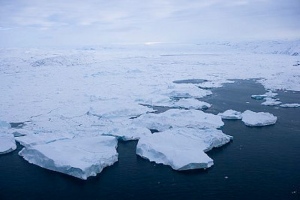
Scientists suspect that melting ice has tilted the North Pole towards Greenland.
Patrick Robert/Corbis
Global warming is changing the location of Earth’s geographic poles, according to a study in Geophysical Research Letters1.
Researchers at the University of Texas, Austin, report that increased melting of the Greenland ice sheet — and to a lesser extent, ice loss in other parts of the globe — have helped to shift the North Pole several centimetres east each year since 2005.
“There was a big change,” says geophysicist and lead author Jianli Chen.
Between 1982 and 2005, the pole drifted southeast towards northern Labrador, Canada, at a rate of about 2 milliarcseconds — or roughly 6 centimetres — per year. But in 2005, the pole changed course and began galloping east towards Greenland at a rate of more than 7 milliarcseconds per year.
Scientists have long known that the locations of Earth’s geographic poles are not fixed. Over the course of the year, they shift seasonally as Earth’s distributions of snow, rain and humidity change. “Usually [the shift] is circular, with a wobble,” says Chen.
But underlying the seasonal motion is a yearly motion that is thought to be driven in part by continental drift. It was the change in that motion that caught the attention of Chen and his colleagues, who used data collected by NASA’s Gravity Recovery and Climate Experiment (GRACE) to determine whether ice loss had shifted and accelerated the yearly polar drift.
GRACE’s twin probes measure changes in Earth’s gravity field, which can be used to track shifts in the distribution of water and ice. Chen’s team used GRACE data to model how melting ice caps affect Earth’s mass distribution. They found that recent accelerated ice loss and associated sea-level rise accounted for more than 90% of the post-2005 polar shift.
Ice loss
The results suggest that tracking polar shifts can serve as a check on current estimates of ice loss, says Erik Ivins, a geophysicist at NASA’s Jet Propulsion Laboratory in Pasadena, California. When mass is lost in one part of a spinning sphere, its spin axis will tilt directly towards the position of the loss, he says — exactly as Chen’s team observed for Greenland. “It’s a unique indicator of the point where the mass is lost,” says Ivins.
Scientists can locate the north and south poles to within 0.03 milliarcseconds by using Global Positioning System measurements to determine the angle of Earth’s spin. Knowing the motion of the poles constrains estimates of ice loss made by other methods, Chen says.
And that could help scientists watching Earth’s ice to bridge a likely data gap between GRACE and its replacement, GRACE II, which NASA has scheduled for launch around 2020. Researchers may also be able to use long-standing records of polar drift to improve estimates of ice loss and growth that occurred before the advent of satellite monitoring.
Chen estimates that data on polar shifts go back roughly a century, well before the advent of Earth-monitoring satellites. “We don’t have a long record of measuring the polar ice sheet,” he says. “But for polar motion, we have a long record.”
